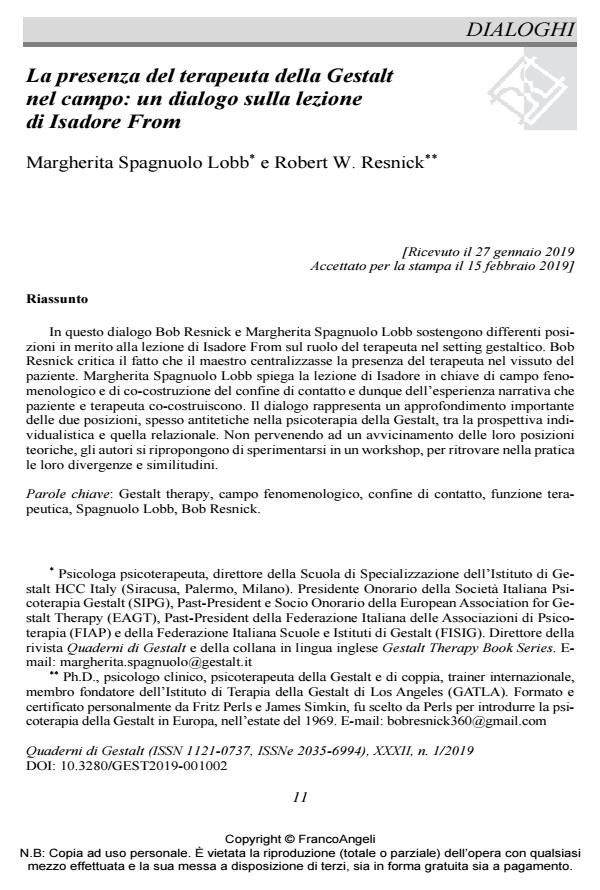The Presence of the Gestalt Therapist in the field. Dialogue on Isadore From’s Lesson
Journal title QUADERNI DI GESTALT
Author/s Margherita Spagnuolo Lobb, Robert W. Resnick
Publishing Year 2019 Issue 2019/1 Language Italian
Pages 18 P. 11-28 File size 233 KB
DOI 10.3280/GEST2019-001002
DOI is like a bar code for intellectual property: to have more infomation
click here
Below, you can see the article first page
If you want to buy this article in PDF format, you can do it, following the instructions to buy download credits

FrancoAngeli is member of Publishers International Linking Association, Inc (PILA), a not-for-profit association which run the CrossRef service enabling links to and from online scholarly content.
In this dialogue Bob Resnick and Margherita Spagnuolo Lobb present to different posi-tions on Isadore From teachings about the role of the therapist and Gestalt therapeutic setting. Bob Resnick criticizes what he considers an overly central position of the therapist used to under stand the client. Margherita Spagnuolo Lobb, on the other hand, draws on a phenome-nological and field perspective in order to explain Isadore’s teachings about how therapist and client co-create their contact boundary. Their dialogue, then, represents consideration of an important historical theme in Gestalt therapy - difference between the individualistic perspective based on the development of the patient’s awareness, which became widespread since the first years after Gestalt therapy’s birth, and the relational approach based on the concepts of contact boundary and a field that is has now become common since the 1980s. This relational approach began with the teachings of Isadore From himself and demonstrated in particular from by this famous Gestalt psycho-therapist with his example a session he connected the adjective "small", attributed by a patient to a dream, to his physical small stature. To Bob Resnick, translating from From’s "therapeutic move" into standard clinical prac-tice represents a risk of monopolization of the setting by the therapist. Instead, the therapist should bring the focus of the patient’s attention to himself only when the patient himself asks for it in an unequivocal way. For Margherita Spagnuolo Lobb, the lesson of From represents a "field reading" by the psychotherapist. In the phenomenological perspective centered on the here-and-now and on a concept of self as an emerging experience in the organism/environment field, the therapist is still part of the patient’s experience for the simple fact that s/he is the one to whom the patient turns to solve his or her discomfort. From a relational point of view, therefore, the psychother-apist can only contribute to constructing the patient’s narrative process. In this dialogue, however, the positions of the authors are not totally incompatible. In one hand, the American colleague admits to what Margherita Spagnuolo Lobb says, that is, that the therapist is always part of the phenomenological field within which the patient’s experience takes shape. On the other hand, the italian colleague agrees with the sense of responsibility underlined by Bob Resnick, when he says that the therapist must recognize if the solicitation to shift the attention of the patient towards other elements of the field, including the therapist, can have therapeutic or iatrogenic effects. Given that these dialogue partners cannot reach an agreement on a matter of theory, they plan to move this discussion to a clinical level, in a workshop in which they can mutually ex-perience being both a therapist and a client. In this way it will be possible to find what is use-ful in one and the other focus.
Keywords: Gestalt therapy, phenomenological field, contact boundary, therapeutic function, Spagnuolo Lobb, Bob Resnick.
- La discrétion. La rencontre avec Isadore From Margherita Spagnuolo Lobb, Joseph Caccamo, in Cahiers de Gestalt-thérapie /2022 pp.81
DOI: 10.3917/cges.047.0081
Margherita Spagnuolo Lobb, Robert W. Resnick, La presenza del terapeuta della Gestalt nel campo: un dialogo sulla lezione di Isadore From in "QUADERNI DI GESTALT" 1/2019, pp 11-28, DOI: 10.3280/GEST2019-001002